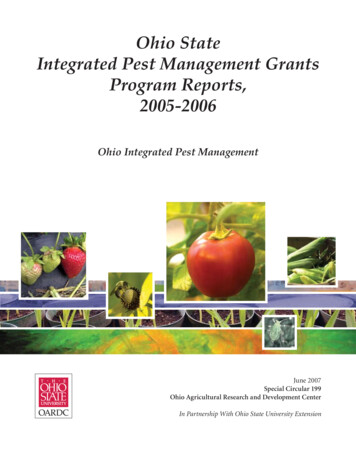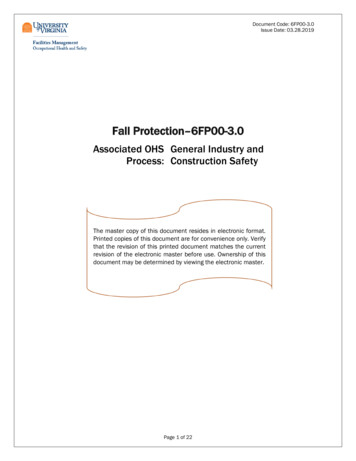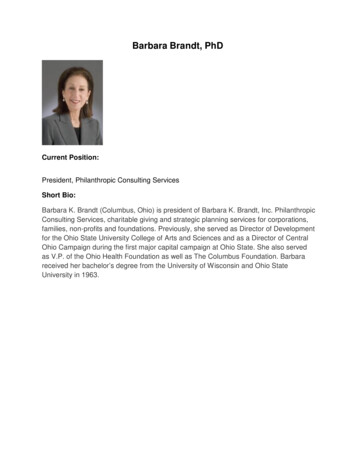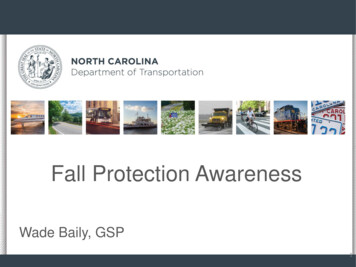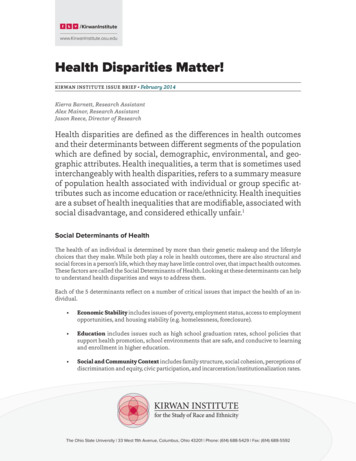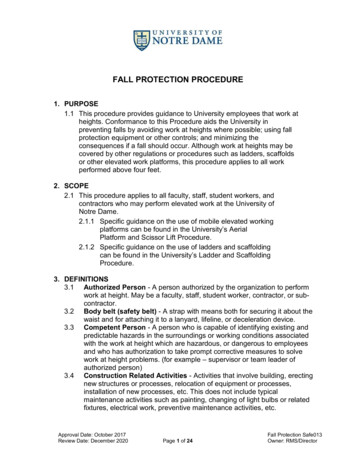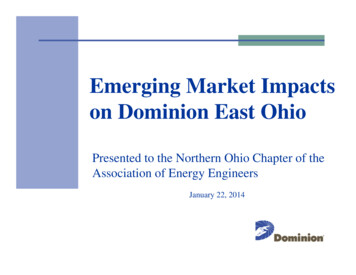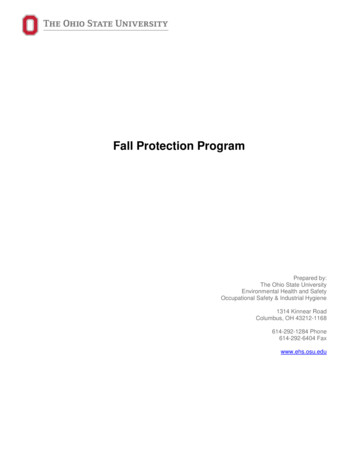
Transcription
Fall Protection ProgramPrepared by:The Ohio State UniversityEnvironmental Health and SafetyOccupational Safety & Industrial Hygiene1314 Kinnear RoadColumbus, OH 43212-1168614-292-1284 Phone614-292-6404 Faxwww.ehs.osu.edu
Page 2Table of Contents1.0Introduction . 32.0Responsibilities . 43.0Definitions . 74.0Fall Hazard Identification & Control Measures . 115.0Fall Protection System Type & Use . 146.0Protection from Falling Objects . 217.0Training. 228.0Maintenance & Inspection . 249.0Recordkeeping . 2510.0Rescue Operations . 2711.0Contractors . 28Appendix A: Sample PPE Inspection Checklist . 29Appendix B: Sample Fall Protection Schematic . 30Appendix C: Fall Protection Checklist . 31Updated 2018
Page 31.0 Introduction1.1 It is the policy of The Ohio State University (OSU) to take precautions to eliminate fall hazards fromelevated work locations. This Fall Protection Program prescribes the duty to provide fall protection;sets the criteria and practices for fall protection; and outlines required training and recordkeeping.1.2 Purpose:The purpose of this program is to outline the fall protection requirements tominimize/eliminate fall related injuries. This program is developed in accordance with the followingOccupational Safety and Health Administration (OSHA) regulations: 29 CFR 1910 Subpart D, “Walking-Working Surfaces”29 CFR 1910 Subpart F, “Powered Platforms, Manlifts, and Vehicle-Mounted Work Platforms”29 CFR 1910.132 “Personal Protective Equipment”29 CFR 1926 Subpart M, “Fall Protection”ANSI/ASSE Z359 Fall Protection1.3 Scope: This Fall Protection Program establishes and outlines the OSU Working Unit, supervisor,competent person, and authorized person responsibilities; identification of fall hazards and controlmeasures; and training, inspection and recordkeeping related to fall protection on/in OSU buildings.The program applies to all OSU employees whose work duties require them to work at unprotectedheights greater than four (4) feet. The use of ladders, scaffolds and aerial lifts are not covered in detailwithin this program. Refer to the OSU Elevated Work & Aerial Lift Safety Program for informationregarding these topics.2.0 Responsibilities2.1 Environmental Health & Safety2.1.1Environmental Health & Safety (EHS) provides program oversight and consultation toOSU working units with fall protection components including training; maintains applicablerecords; performs program reviews and updates as necessary; and providesrecommendations for fall protection during the building design process.2.2 OSU Working Unit (Facilities Operations & Development (FOD); Athletics; OSU Wexner MedicalCenter (OSUWMC); Student Life; et al.)2.2.1The working unit responsible for each building where fall protection is provided, or wherefall hazards exist as part of an employee’s job duties, shall be responsible forimplementing the fall protection program and ensuring specific fall hazards are identifiedand adequately controlled through engineering and/or administrative controls. In addition,working units shall assign a “competent individual/person” responsible for departmentalfall protection program administration, implementation and maintenance includingequipment inspections, inventory, training and recordkeeping.2.3 FOD Facilities Design & Construction (FDC)2.3.1FDC shall ensure all new construction and renovations, where applicable, include anengineered fall protection component as required by The Ohio State Building DesignStandards, Division 11-Equipment; 11.01.92-Perminant Fall Protection Systems (Roof).The preferred methods of fall protection are as follows:2.3.1.1 A parapet (equal to or greater than 42 inches) along the perimeter of work areason rooftops.Updated 2018
Page 42.3.1.2 A 42-inch guardrail is to be around the perimeter of the roof.2.3.1.3 A fall protection system where fall hazards exist and are protected by a parapet orguardrail.2.3.2FDC shall ensure all engineered fall protection systems include both the hardwarecomponents and the personal protective equipment, which is designed, manufactured andcompatible for that system.2.4 Supervisors2.4.1OSU employees who supervise personnel with responsibilities to work where fall hazardsexist must be informed of the contents of this program; identify a competent person toaddress fall hazards; and ensure compliance with the fall protection program and relatedstandards. Supervisors are responsible for ensuring all persons affected by the fallprotection program are properly trained prior to encountering fall hazards.2.5 Authorized Person2.5.1Employees working where fall hazards exist must comply with the provisions of thisprogram including the use of personal protective equipment (PPE), fall protectionequipment and rescue systems/operations; completion of equipment inspections; training;and reporting of any concerns related to fall protection.2.6 Competent Person2.6.1Employees delegated the competent person shall be responsible for the oversight,implementation and management of the fall protection program2.6.2The competent person shall:2.6.2.1 Be knowledgeable through training and experience of applicable fall protectionstandards and regulations applicable to their operation(s)2.6.2.2 Conduct fall hazard surveys (job hazard analyses) to identify fall hazards beforeauthorized persons are exposed to fall hazards.2.6.2.3 Have the authority to stop work immediately if it is determined unsafe to proceed.2.6.2.4 Prepare, update, and review written fall protection procedures and ensure awritten rescue plan is developed for situations where fall hazards exist.2.6.2.5 Specify in, written fall protection procedures, the systems in place to includeanchorage points, connecting means, and other fall protection equipment thatauthorized persons are required to use when exposed to a fall hazard.2.6.2.6 Supervise the selection, installation, use and inspection of noncertified anchorpoints.2.6.2.7 Verify the fall protection systems are installed and inspected in compliance withthis plan and applicable standards.2.6.2.8 Verify and ensure all authorized persons working at heights are trained andauthorized to do so.Updated 2018
Page 52.6.2.9 Ensure a prompt rescue of authorized persons can be accomplished throughadequate rescue operations.2.6.2.10Participate in investigations of all incidents related to falls from elevatedwork surfaces.2.6.2.11Immediately remove from service any fall protection equipment founddefective or subjected to forces as a result of a fall from elevated work.2.6.2.12Inspect fall protection equipment as recommended by the manufacturerand specified in this plan and ensure inspections by qualified persons areconducted as required.3.0 DefinitionsAnchorage/Anchor point: secure point of attachment for lifelines, lanyards or deceleration devices.Authorized person: a person assigned by employer to perform duties at a location where the person will beexposed to a fall hazard.Body belt (safety belt): a strap with means both for securing it about the waist and for attaching it to a lanyard,lifeline, or deceleration device.Body harness: straps which may be secured about the employee in a manner that will distribute the fall arrestforces over at least the thighs, pelvis, waist, chest and shoulders with means for attaching it to othercomponents of a personal fall arrest system.Competent Person/Individual: one who is capable of identifying existing and predictable hazards in the workenvironment and who has the responsibility to inspect fall protection systems for certification purposes.Persons/individuals are deemed competent through a combination of training and hands-on experience topossess knowledge about all aspects of the fall protection program and fall protection equipment.Dangerous equipment: equipment (such as cooling towers, fuel storage tanks, silos, etc.) which, as a result ofform or function, may be hazardous to employees who fall onto or into such equipment.Deceleration device: any mechanism, such as a rope grab, rip-stitch lanyard, specially-woven lanyard, tearingor deforming lanyards, automatic self-retracting lifelines/lanyards, etc., which serves to dissipate a substantialamount of energy during a fall arrest, or otherwise limit the energy imposed on an employee during fall arrest.Deceleration distance: the additional vertical distance a falling employee travels, excluding lifeline elongationand free fall distance, before stopping, from the point at which the deceleration device begins to operate. It ismeasured as the distance between the location of an employee's body belt or body harness attachment pointat the moment of activation (at the onset of fall arrest forces) of the deceleration device during a fall, and thelocation of that attachment point after the employee comes to a full stop.Free fall: the act of falling before a personal fall arrest system begins to apply force to arrest the fall.Guardrail system: a barrier erected to prevent employees from falling to lower levels.Hole: a gap or void 2 inches (5.1 cm) or more in its least dimension, in a floor, roof, or other walking/workingsurface.Lanyard: a flexible line of rope, wire rope, or strap which generally has a connector at each end for connectingthe body belt or body harness to a deceleration device, lifeline, or anchorage.Updated 2018
Page 6Leading edge: the edge of a floor, roof, or formwork for a floor or other walking/working surface (such as thedeck) which changes location as additional floor, roof, decking, or formwork sections are placed, formed, orconstructed. A leading edge is considered to be an "unprotected side and edge" during periods when it is notactively and continuously under construction.Lifeline: a component consisting of a flexible line for connection to an anchorage at one end to hang vertically(vertical lifeline), or for connection to anchorages at both ends to stretch horizontally (horizontal lifeline), andwhich serves as a means for connecting other components of a personal fall arrest system to the anchorage.Low-slope roof: a roof having a slope less than or equal to 4 in 12 (vertical to horizontal)Lower levels: those areas or surfaces to which an employee can fall. Such areas or surfaces include, but arenot limited to, ground levels, floors, platforms, ramps, runways, excavations, pits, tanks, material, water,equipment, structures, or portions thereof.Mechanical equipment: all motor or human propelled wheeled equipment used for roofing work, exceptwheelbarrows and mop carts.Opening: a gap or void 30 inches (76 cm) or more high and 18 inches (48 cm) or more wide, in a wall orpartition, through which employees can fall to a lower level.Personal fall arrest system: a system used to arrest an employee in a fall from a working level. It consists ofan anchorage, connectors, a body belt or body harness and may include a lanyard, deceleration device,lifeline, or suitable combinations of these. As of January 1, 1998, the use of a body belt for fall arrest isprohibited. Fall arrest systems are engineered to be compatible between the permanent system and thepersonal protective equipment. Interchanging the components is not permitted.Personal fall restraint system: fall protection system, which prevents an employee from approaching a fallhazard through the use of a lanyard and body harness.Positioning device system: a body belt or body harness system rigged to allow an employee to be supportedon an elevated vertical surface, such as a wall, and work with both hands free while leaning.Qualified person: a person with a recognized degree or professional certificate AND with extensive knowledge,training and experience in the fall protection and rescue field who is capable of designing, analyzing,evaluating and specifying fall protection and rescue systems.Roof: the exterior surface on the top of a building. This does not include floors or formwork which, because abuilding has not been completed, temporarily becomes the top surface of a building.Roofing work: the hoisting, storage, application, and removal of roofing materials and equipment, includingrelated insulation, sheet metal, and vapor barrier work, but not including the construction of the roof deck.Safety-monitoring system: a safety system in which a competent person is responsible for recognizing andwarning employees of fall hazards.Self-retracting lifeline/lanyard: a deceleration device containing a drum-wound line which can be slowlyextracted from, or retracted onto, the drum under slight tension during normal employee movement, andwhich, after onset of a fall, automatically locks the drum and arrests the fall.Shock-absorbing lanyard: a lanyard with energy absorbing capacityUpdated 2018
Page 7Snaphook: a connector comprised of a hook-shaped member with a normally closed keeper, or similararrangement, which may be opened to permit the hook to receive an object and, when released, automaticallycloses to retain the object. Snaphooks are generally one of two types: The locking type with a self-closing, self-locking keeper which remains closed and locked untilunlocked and pressed open for connection or disconnection; orThe non-locking type with a self-closing keeper which remains closed until pressed open forconnection or disconnection. As of January 1, 1998, the use of a non-locking snaphook as part ofpersonal fall arrest systems and positioning device systems is prohibited.Standard Railing: railing or safety railing system which meets the requirements for top rail, mid-rail, andtoeboard specifications.Toeboard: a low protective barrier that will prevent the fall of materials and equipment to lower levels andprovide protection from falls for personnel.Unprotected sides and edges: any side or edge (except at entrances to points of access) of a walking/workingsurface, e.g., floor, roof, ramp, or runway where there is no wall or guardrail system at least 39 inches (1.0 m)high.Walking/working surface: any surface, whether horizontal or vertical on which an employee walks or works,including, but not limited to, floors, roofs, ramps, bridges, runways, formwork and concrete reinforcing steel butnot including ladders, vehicles, or trailers, on which employees must be located in order to perform their jobduties.Warning line system: a barrier erected on a roof to warn employees that they are approaching an unprotectedroof side or edge, and which designates an area in which roofing work may take place without the use ofguardrail, or body belt, systems to protect employees in the area.Updated 2018
Page 84.0 Fall Hazard Identification & Control MeasuresIt is the intent of this program is to ensure all fall hazards are appropriately addressed to protect workers frominjury. All newly constructed buildings, building renovations as well as roof repair or replacement projectsmust comply with Federal OSHA, consensus industry standards and OSU Building Design Standards andprovide safe work areas. The following addresses potential fall hazards and applicable control measures.4.1 Unprotected sides and edges4.1.1Employees on a work surface with an unprotected side or edge which is 4 feet or moreabove a lower level shall be protected from falling by the use of a guardrail system orpersonal fall restraint or arrest system.4.1.1.1 If one of these systems is not available or is infeasible during leading edge work,a specialized fall protection plan must be developed and implemented to protectworkers from fall hazards.4.1.1.2 Hoist areas shall be protected by guardrail or personal fall arrest systems. Ifguardrail systems or portions of guardrail systems are removed to facilitate thehoisting process creating a potential fall hazard for the employee, that employeemust be protected by a personal fall arrest system.4.1.1.3 Unprotected sides and edges 4 feet above the lower level shall be protected by aguardrail system. Loading docks more than 4 feet above a lower level are notrequired to have a guardrail system on the working side of the dock where it canbe demonstrated that the presence of guardrails would prevent the performanceof work. All non-working sides of a loading dock must be protected by a guardrailsystem. Dock doors shall remain closed when not in use to minimize the fallhazard and all personnel working around loading docks shall be trained torecognize and avoid the applicable fall hazards.4.2 Holes and excavations4.2.1.1 Floor openings, holes, manholes, roof hatches, and skylights. Employees on awork surface where floor openings, holes, manholes, roof hatches and skylightspresent fall hazards of 4 feet or more shall be protected from falling by guardrailsystems erected around the hole, covers over the openings, or by personal fallarrest systems.4.2.1.1.1Where covers are used as fall protection measures, they shall remainin place when not in use. If removed, the fall hazard must beattended by a designated employee who is protected by a removableguardrail system.4.2.1.1.2Where skylights are in place, their design must meet applicablebuilding codes and OSU Building Design Standards; and shall be ofsuitable strength to prevent a fall, protected by a guardrail system, orrequire the use of a personal fall arrest system.4.2.1.1.2.1 Covers located in roadways and vehicular aisles shall becapable of supporting, without failure, at least twice themaximum axle load of the largest vehicle expected to crossover the coverUpdated 2018
Page 94.2.1.1.2.2 All other covers shall be capable of supporting, withoutfailure, at least twice the weight of employees, equipment andmaterials that may be imposed on the cover at any one time.4.2.1.1.2.3 All covers shall be secured when installed so as to preventaccidental displacement by the wind, equipment oremployees4.2.1.1.2.4 All covers shall be color coded or be marked with the work“HOLE” or “COVER” to provide warning of the hazard.NOTE: These provisions do not apply to cast iron manholecovers or steel grates used on streets or roadways.4.2.1.2 Excavations. Employees working at the edge of an excavation 4 feet or more indepth shall be protected from falling by guardrail systems, fences, barricades, orpersonal fall arrest system. This includes trenches, wells, pits, shafts or othersimilar excavations.4.2.1.2.1Excavations where the public may be exposed shall be addressed asrequired by OSU Building Design Standards to not create potentialfall hazards.4.2.1.2.2Refer to the OSU Trenching and Excavating Safety Program foradditional information and training.4.3 Dangerous equipment4.3.1.1 Employees less than 4 feet above dangerous equipment shall be protected fromfalling into or onto the equipment by guardrail systems or equipment guards.4.3.1.2 Employees more than 4 feet above dangerous equipment shall be protected fromfall hazards by guardrail, personal fall arrest, or warning line systems.4.4 Scaffolds, aerial lifts, and ladders4.4.1.1 Fall hazards associated with scaffolds, aerial lifts and ladders are addressed inthe OSU Elevated Work Program. Fall hazards on scaffolds shall be addressedby the installation of a guardrail system. Fall arrest systems may also bewarranted based on the type of work being conducted. Employees utilizing aeriallifts shall be protected from fall hazards according to the manufacturer’srecommendations including guardrail systems, fall restraint systems, and fallarrest systems.4.5 Building rooftops4.5.1All new construction or renovation/repair to existing roof systems shall incorporateengineered fall protection into the project design. This includes guardrail systems(including parapets) and/or personal fall arrest or fall restraint systems. Fall protectiondesign shall be approved by a Professional Engineer as required by the OSU BuildingDesign Standards.Updated 2018
Page 104.5.1.1 On buildings where fall restraint or fall protection is installed, only authorizedpersonnel may perform work. Fall protection system inspections and personneltraining are addressed in sections 7 and 8 of this program.4.5.1.2 Equipment designed and engineered for use as a fall protection system on arooftop may not be interchanged with other fall protection systems. Including fallrestraint systems and personal protective equipment.4.5.2On buildings where no rooftop fall protection is provided by a permanent guardrail system(including parapets) or fall arrest/restraint system, the supervisor must create a fallprotection plan, based on the work being done, prior to employees accessing a rooftop.This may include the use of a mobile anchor point; temporary guardrail and/or a safetymonitoring system (see section 5). In addition, many of the roof tops on OSU buildingshave designated walk paths. Employees utilizing the walk paths are not required to be infall protection equipment. Any time employees must access rooftop areas between theroof edge and the walk path, fall protection equipment is required.Updated 2018
Page 115.0 Fall Protection System Type & UseFall protection systems incorporated into building or facility design shall meet all applicable standardsincluding, but not limited to, ANSI A10.32-2004 Fall protection systems for construction and demolitionoperations; ANSI Z359 Fall Protection Code; OSHA 29 CFR Part 1910 Subpart D-Walking and workingsurfaces; OSHA 29 CFR 1910 Subpart I-Personal protective equipment; OSHA 29 CFR 1926 Subpart M-Fallprotection; The Ohio State University Building Design Standards for Associate Architects and Engineers.Choosing fall protection systems. The hierarchy of controls, or preferred order of controls, shall be used tochoose methods to eliminate or control fall hazards. Conventional fall protection systems. Conventional fall protection systems provide the greatestprotection against fall hazards and should be considered a priority when addressing employeeprotection.1. Standard guardrail system2. Fall restraint system3. Personal fall arrest system Specialized fall protection systems. If conventional fall protection systems are not practical or feasible,the use of a specialized fall protection system including a warning line system or safety monitoringsystem must be utilized to protect employees from fall hazards.1. Warning line system2. Safety monitoring system3. Mobile, temporary anchor pointConventional fall protection systems:5.1 Guardrail systems. Installed and temporary guardrail systems shall comply with OSHA 29 CFR1910.23-Guarding floor and wall openings and holes. Guardrail systems installed during constructionprojects and activities shall comply with OSHA 29 CFR 1926.502-Fall protection systems criteria andpractices. Guardrail systems provide a barrier to prevent employees from falling to lower levels, andwhich designates an area in which work may take place without the use of additional fall protectionPPE.5.1.1Where guardrail systems are in place as a fall protection measure, the railing shall have avertical height of 42 inches ( /-3 inches) measured from the upper surface of the top rail tothe working surface and consist of a top rail, intermediate rail, and posts. Midrails,screens, mesh, intermediate vertical members, or equivalent intermediate structuralmembers shall be installed between the top edge of the guardrail system and thewalking/working surface when there is not wall or parapet wall at least 21 inches high.Guardrails shall be so surfaced as to prevent injury to an employee from punctures orlacerations, and to prevent snagging of clothing.5.1.1.1 The intermediate rail shall be approximately halfway between the top rail and theworking surface.5.1.1.2 Guardrail systems must be capable of withstanding, without failure, a force of atleast 200 pounds in any direction. Refer to Table 1 for material specifications forguardrail systems.Updated 2018
Page 125.1.1.2.1When 200 pounds of force is applied in a downward direction, the topedge of the guardrail shall not deflect to a height less than 39 inchesabove the working surface.5.1.1.2.2The ends of all top rails and midrails shall not overhang the terminalposts, except where such overhang does not constitute a projectionhazard.5.1.1.2.3Top rails and midrails shall be at least ¼ inch nominal diameter orthickness to prevent cuts and lacerations. If wire rope is utilized fortop rails, it shall be flagged at not more than 6 foot intervals with highvisibility material.5.1.1.3 Stair railings shall be not more than 34 inches or less than 30 inches from theupper surface of the top rail to the forward edge of the tread surface.5.1.1.4 A standard toeboard shall be provided on all guardrail systems where personscan pass under the work surface; there is moving machinery; and/or equipmentutilized on the elevated surface with which falling equipment creates a hazard.Toeboards shall be 3.5 inches nominal in vertical height and securely fastened inplace with not more than ¼ inch clearance above the working surface. Wherematerial is stored near the guardrail system, at heights exceeding the toeboard,paneling from the work surface to the intermediate rail shall be provided.5.1.1.4.1Toeboards shall be capable of withstanding, without failure, a force ofat least 50 pounds applied in any downward or outward direction atany point along the toe board.5.1.1.5 Engineered guardrail systems may be utilized provided they meet theserequirements and are installed as per the manufacturer’s specifications.Updated 2018
Page 13Table 1: Guardrail system specificationsMaterial ofPost er5.1.2Top railrequirementsIntermediate railrequirements2-inch by 4-inchstock spaced 6 feetapart2-inch by 4-inchstock2-inch by 4-inchstock1 ½ inches nominaldiameter spacednot more than 8 feeton center1 ½ inches nominal1 ½ inches nominal2”x2”x3/8” anglesspaced not morethan 8 feet oncenter2”x2”x3/8” angles2”x2”x3/8” anglesProvide strength totop rail to support200 pounds appliedin any directionSmooth surface at aheight 42-inchesabove the worksurface, capable ofwithstanding 200pounds top railpressureProtection betweentop rail and floorequivalent to thatafforded bystandardintermediate railsAdditionalrequirementsIf top rail is two rightangle pieces of1”x4”, posts may bespaced 8 feet oncenter. Woodcomponents shallbe min. 1500 lbft/in2 fiber (stressgrade)Portable guardrail systems may be utilized as a fall protection measure provided theymeet the OSHA and ANSI guardrail specification requirements.5.2 Fall restraint systems. These systems are typically installed on aerial lifts and boom lifts. Refer to theappropriate regulations and OSU programs for additional information on fall restraint systems andaerial lifts. Fall restraint systems may also be utilized on elevated work surfaces as a preventativemeasure against fall hazards or as a positioning device system. These systems prevent an employeefrom approaching a fall hazard through the use of a lanyard and body harness.Updated 2018
Page 145.2.1The restraint lanyard must be short enough to prevent a fall from occurring; be protectedagainst cutting and abrasion; and attach the body harness directly to the anchor pointindependently of any other lines.5.2.2When used as a positioning device system, the lanyard length shall be rigged such that anemployee cannot free fall more than 2 feet.5.2.3Full body harness or belt use is required when utilizing fall restraint systems.5.2.4Anchor points must be capable of supporting at least twice the potential impact load of anemployee’s fall or 3,000 pounds, whichever is greater. Positioning devices shall besecured to an anchorage capable of supporting at least twice the potential impact load ofan employee’s fall, or 3,000 pounds.5.2.5All components of the fall restraint system including connectors, dee-rings, snaphooks,lanyards and body harnesses/belts shall meet all applicable ANSI and OSHArequirements.5.2.6Fall protection equipment shall not be used to hoist equipment or tools to an elevatedwork surface. This includes window washing equipment.5.2.7Fall protection equipment including restraint lanyards and body harnesses should bestored in a well-ventilated, clean, dry area free from temperature and humidity extremes,corrosive materials or other contaminants. Newly installed fall protection systems requirestorage of equipment be in a lockable, ventilated metal cabinet, as per OSU BuildingDesign Standards.5.3 Fall arrest system. These systems are employed to prevent injury to employees if a fall fro
2.3.1.3 A fall protection system where fall hazards exist and are protected by a parapet or guardrail. 2.3.2 FDC shall ensure all engineered fall protection systems include both the hardware components and the personal protective equipment, which is designed, manufactured and compatible for that system. 2.4 Supervisors
